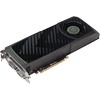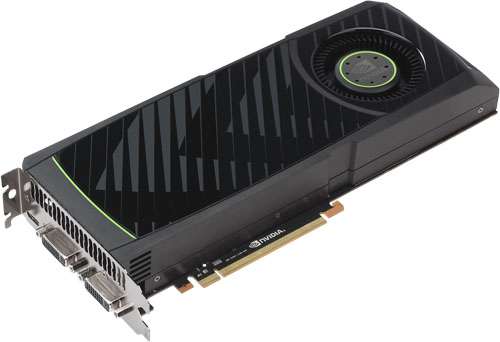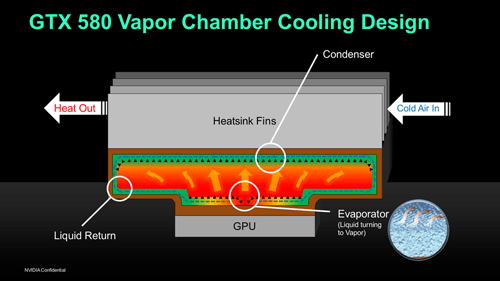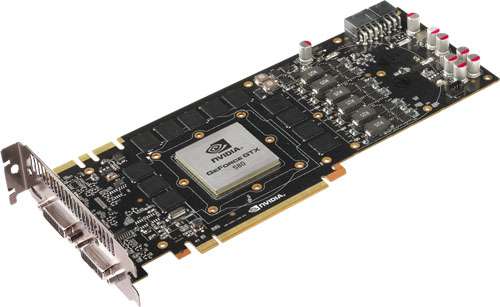- Qualcomm Launches Snapdragon 4 Gen 2 Mobile Platform
- AMD Launches Ryzen PRO 7000 Series Mobile & Desktop Platform
- Intel Launches Sleek Single-Slot Arc Pro A60 Workstation Graphics Card
- NVIDIA Announces Latest Ada Lovelace Additions: GeForce RTX 4060 Ti & RTX 4060
- Maxon Redshift With AMD Radeon GPU Rendering Support Now Available
NVIDIA GeForce GTX 580

NVIDIA launched its first Fermi-based GPU earlier this year in the form of the GeForce GTX 480, and it was met with mixed reception. Until now, it’s been the fastest single-GPU offering on the market, but certain downsides kept it from being the first-choice of many. Does NVIDIA’s first proper follow-up fix all that was wrong?
Page 1 – Introduction
NVIDIA’s GeForce GTX 580 might just be one of the least secretive GPU launches that has ever occurred, and it’s clear that NVIDIA itself didn’t mind. Even it accidentally leaked the card on its own website a couple of weeks ago, and around the same time, ASUS did the same on its Chinese site. There, it even leaked a rumored price (which turned out to be wrong).
This launch is a little interesting, because chances are good that almost everyone reading this is going to be familiar with the card and understand what purpose it’s set out to serve. This is NVIDIA’s follow-up to the first Fermi card it released earlier this year, the GeForce GTX 480, proving to be more power efficient, cooler, faster, and priced identically.
Is that enough to get excited about? According to some, the GTX 580 is what the GTX 480 should have been… a true follow-up to the company’s GTX 200 series of cards that gamers could brag about. As we mentioned in our launch article, however, the launch wasn’t quite ideal. NVIDIA even backed up our points months later – a true rarity.
AMD a couple of weeks ago released its Radeon HD 6800 series of graphics cards, and in no way is the GTX 580 out to compete with those. Both target different markets, with NVIDIA looking skyward and AMD giving mainstream gamers some good choices. What this is though, is NVIDIA’s way of preempting AMD’s HD 6900 launch later this month – a series that will feature both high-end single and dual-GPU cards.
Based on these facts alone, is there reason to jump for your wallet? It depends. If you’re looking for the fastest single-GPU card out there, the GTX 580 is without question it. That fact is verified by the fact that the GTX 480 in which it replaces also was. The potential problem, though, is with pricing. At $500, the GTX 580 is priced much higher than AMD’s line-up, and for those who are willing to go the CrossFireX or SLI route, a better value could likely be had.
Closer Look
The GTX 580, despite its name, does not feature a new architecture, but rather a tweaked one. The process size remains the same, so to help improve things, NVIDIA spent a lot of time fixing things that weren’t ideal with launch Fermi cards and aimed to deliver a card that drew less power, had better power handling, and of course, was made faster. As we’ll see, it certainly did all those.
For those interested, here’s a quick overview of NVIDIA’s current GPU line-up (note that the GTX 480 is for the most part deprecated, but is here for comparison’s sake).
|
Model
|
Core MHz
|
Shader MHz
|
Mem MHz
|
Memory
|
Bus Width
|
Cores
|
| GeForce GTX 580 |
772
|
1544
|
4008
|
1536MB
|
384-bit
|
512
|
| GeForce GTX 480 |
700
|
1401
|
3696
|
1536MB
|
384-bit
|
480
|
| GeForce GTX 470 |
607
|
1215
|
3348
|
1280MB
|
320-bit
|
448
|
| GeForce GTX 465 |
607
|
1215
|
3206
|
1024MB
|
256-bit
|
352
|
| GeForce GTX 460 |
675
675 |
1350
1350 |
3600
3600 |
768MB
1024MB |
192-bit
256-bit |
336
336 |
| GeForce GTS 450 |
783
|
1566
|
3608
|
1024MB
|
128-bit
|
192
|
A major focus for NVIDIA with this card was to achieve the best performance per watt ratio, and in its examples, it compared those results to the GTX 480 and not the competition. It can be assumed that power is improved, but not to the extent of current Radeon’s. In a similar vein, to help make up for the leaf-blower audio from the GTX 480, NVIDIA wanted to make the GTX 580 quieter, and it did manage that, dropping from 52dBA to 46dBA at full load.
Because NVIDIA sent us photos of the exact same card we received, I am choosing to use its photos instead for the sake of time (much quicker to use its photos than to tear the cooler off!). As you can see, the card isn’t a far stretch from the GTX 480, though it does feature a slightly different aesthetic design and completely rids the heat-pipes. How could that be?
In lieu of traditional heat-pipes, NVIDIA worked with some undisclosed vendor to design a “vapor chamber” cooler that has a similar overall execution. Water boils and rises to the top, and heat dissipates through the fins. It seems like a simple idea, but as we’ll see later, it’s actually pretty effective, and a big improvement over the GTX 480 design.
With the cooler off, you’d almost swear that this was the GTX 480, not the GTX 580. The design remains largely similar, but unfortunately I’m not sure at this time if that means that after-market coolers designed for the GTX 480 will also fit this card.
Like before, the GTX 580 features two DVI ports and also a mini-HDMI. For a triple-display setup, you will be required to use two GTX 580’s due to NVIDIA’s design.
Also like the GTX 480, this card requires an 8 and 6-pin PCIe power connector, but is rated at a much more modest 244W. That’s in part to the various tweaks made to the design, and also the improved power management. Now, let’s see what NVIDIA’s latest is capable of… but not before taking a quick look at our testing methodology.
Support our efforts! With ad revenue at an all-time low for written websites, we're relying more than ever on reader support to help us continue putting so much effort into this type of content. You can support us by becoming a Patron, or by using our Amazon shopping affiliate links listed through our articles. Thanks for your support!









